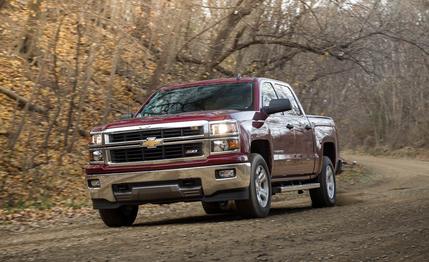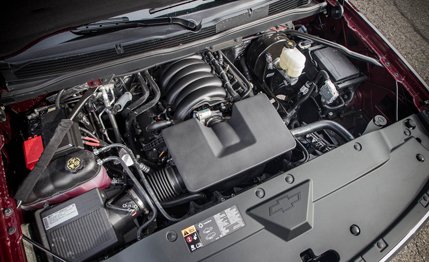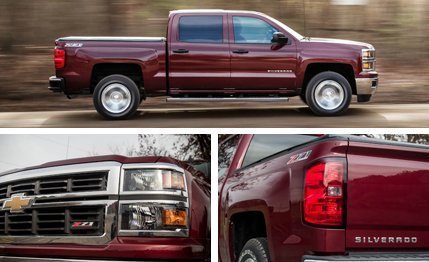 Instrumented Test
Instrumented Test
Sometime during the seven model years of the previous-generation Silverado, we lost track of how many different engines Chevrolet offered. Actually, we just quit counting when we ran out of fingers. There were V-8s in four different displacements, one of which, the 5.3-liter, came in both iron- and aluminum-block versions, and with and without FlexFuel E85 capability. GM would rather strike from the annals of history its “two-mode” hybrid pickup, which proved to have only one mode: salesproof. And what ever happened to the plug-in conversion that Bob Lutz was hawking at the 2012 Detroit auto show?
Lest we forget, there was also a V-6, a choice that was, in fact, forgotten by retail customers. Chevrolet says it accounted for only 5 percent of sales, and most of those went into fleets. Yet, a V-6 returns as the base engine in the redesigned 2014 Silverado in consideration of the new strain of frugality afflicting full-size trucks. It’s an aluminum-block 4.3-liter rated at 285 horsepower and 305 pound-feet of torque. It even has a new name, Ecotec3, to help distinguish it from last year’s 195-hp 4.3-liter Vortec V-6 with its cast-iron block and heads.

You will not see a multi-million-dollar branding campaign (like the one Ford has for its EcoBoost F-150) touting GM’s new engine, but the naturally aspirated V-6 benefits from modern technologies, including direct injection and variable valve timing. This helped our V-6–powered Silverado turn a quarter-mile time of 15.7 seconds at 89 mph. That’s a tenth of a second faster than the 6.0-liter V-8 “VortecMAX” Silverado we tested back in 2007. But there is a catch: We had E85 in the tank this time. GM’s latest FlexFuel truck engines get an output bump from ethanol, which helps the new V-6 make 297 horses and 330 pound-feet of torque. Ethanol’s downside is that, owing to a lower energy density than gasoline, it hurts fuel economy; the EPA combined estimate for a V-6, four-wheel-drive Silverado drops from 19 miles per gallon to just 13.
Burning just gas, our quarter-mile time increased to 16 seconds flat at 87 mph. And no matter which fuel you put in the V-6, it’s still off the pace of the new and much ballyhooed LT1 V-8 that did 15.3 seconds at 92 mph.
The Chevy V-6 is also less refined than its bigger brother, the 5.3-liter V-8, which is a $1095 option on LT trims and standard on LTZ models. It’s much coarser, too, than Chrysler’s polished Pentastar 3.6-liter V-6, the minivan motor that’s found its way under the hood of Ram pickups and is the standard-bearer in the entry-level V-6 pickup class that also includes the F-150’s 3.7-liter. A single balance shaft can’t keep the Silverado V-6 from shaking a bit at idle, and vibrations can be felt through both the gas pedal and steering wheel while accelerating. The workmanlike six-speed automatic shared by all new Silverado models also lacks the seamlessness of the Ram’s eight-speed.

On the highway, however, the V-6 Silverado cruises quietly and comfortably. A Silverado won our last pickup comparo, and the V-6 model has the same responsive chassis, with good steering and brake feel. A slippery torque converter masks the power deficit until you hit an on-ramp. Chevy says the V-6 Silverado can even be equipped to tow up to 7600 pounds. The V-6 has cylinder deactivation like the V-8, though it doesn’t switch to V-4 mode nearly as often. We still averaged 16 miles per gallon, 3 mpg better than in the V-8.
The biggest problem with the Silverado V-6 likely has nothing to do with engineering and everything to do with being mistaken for its miserable Vortec predecessor. Sharing a displacement and a 90-degree angle between their cylinder banks, both engines are essentially V-8s with two cylinders chopped off—though the new one is based on the fifth generation of Chevy’s small-block architecture, while the previous engine’s roots reach back to 1955.
Good luck to the Bow-Tie salesmen who have to explain this argot. It will be challenge enough convincing Chevy-pickup buyers—many of whom haven’t set foot in a dealership since The Sopranos was still on HBO—that a naturally aspirated V-6 is up to the task of motivating a 5477-pound full-size pickup with four-wheel drive. Even if, at least in this case, it is.